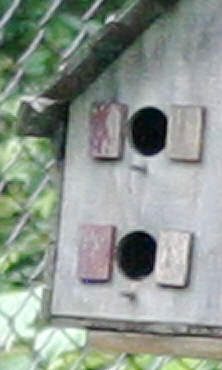
• Fall Foliage Photography
|
Teleconverters - Are they useful?Teleconverters - also known as multipliers - are optical devices which when attached to the rear of a lens increase the effective focal length. They typically come in two "flavors", a 1.4x and a 2x - though 1.5x, 1.7x and 3x versions are not unheard of. 1.4x and 2x are the most common though and the reason for this may well be a holdover from the days when external light meters were used with cameras. When used with a 1.4x TC, a lens requires 1 stop more exposure than without the TC, and with a 2x it requires 2 stops more exposure. In the days of hand held meters and full stop exposure settings it was obviously easier to work in whole stops! So are they useful? Do they make your 300mm zoom lens into a 600mm super zoom telephoto for only $100? The answers are yes and no, in that order! TCs work better with fairly long focal length prime lenses than with short focal length lenses and zooms. So you can put a 1.4x TC on a Canon EF 300/4L lens and expect to get a high quality 420/5.6 lens, but if you put a 1.4x TC on a 20-35 zoom, you may well be disappointed in the results. Some TCs are designed only for use with certain lenses. For example the Canon EOS TCs are only made to be used with (and will only physically fit on) the "L" series telephoto prime lenses and a handful of "L" series zooms (e.g. EF 100-400/4.5-5.6L IS, EF 70-200/4L, EF 70-200/2.8L). Nikon made two sets of TCs, one for lenses over 300mm and one for lenses under 300mm. 3rd party manufacturers (Sigma, Tokina, Tamron, Kenko) usually make TC that will physically fit on any lens of a camera line (e.g. ALL Canon EOS lenses), though that can mean a compromise of optical results in exchange for the greater usability with "consumer" and zoom lenses. AutofocusMost Canon EOS bodies require that the final aperture of the lens be f5.6 or faster in order for autofocus to operate. Since a 1.4x TC cost you 1 stop of aperture and a 2x costs you 2, this means that for a lens to AF with a 1.4x TC it must start out at f4 or faster, and for it to AF with a 2x it must start out at f2.8 or faster.The EOS-3 and the EOS-1 series bodies (1v and the 1D and 1Ds) will autofocus at f8, so with them you can get AF with an f5.6 lens + 1.4x or an f4 lens +2x. Some non-Canon 3rd party TCs do not convey the true aperture of the (lens + TC) combination to the camera body and so the camera will attempt to autofocus even if the effective aperure is lower than f5.6 (of f8 of the EOS 1/3 series). Sometimes AF may work, sometimes it may not. AF may be reliable or it may not be. It's very dependant on the specific TC and the specific lens it's being used with, as well as the brightness and contrast of the subject. There are also some tricks involving blocking off some of the contact pins of the Canon TCs which will allow AF to try to work under conditions where Canon normally turns it off. Again AF won't be reliable when using such tricks.
How well do TCs work, Optically speaking?So how well do they work. Well here are a series of test images that might give you some idea. I used a Tamron 1.4x TC (the one shown above) with three different lenses/. First a Canon EF75-300/4-5.6IS, representative of a consumer grade telephoto zoom, second a Canon EF28-135IS, representative of a reasonably good consumer grade mid-range zoom, third a Canon EF300/4L, representative of an excellent "L" series prime lens and fourth, a Canon EF50/1.8 representative of an inexpensive consumer grade prime lens In each case the images have been adjusted to the same final size by digitally upsizing the image shot without the TC to the same size as that shot with the TC. Upsizing was done using a bicubic algorithm. There are other upsizing software options (e.g. genuine fractals), but I very much doubt that their use would yield significantly different conclusions. If the information isn't there in the first place, no upsizing algorithm can accurately create it! The EF75-300/4-5.6IS[Note this is the older 75-300/4-5.6IS, not the new 70-300/4-5.6IS (which is tested here)] In this first test, shots were taken using an EOS 10D with an EF75-300/4-5.6IS lens set to 300mm and f5.6, with and without a Tamron 1.4x TC attached. Below is the full frame shot 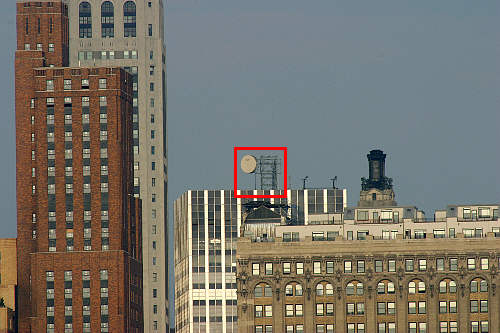 The area in red is shown enlarged below. On the left is a 100% crop of the shot taken using the 1.4x TC. On the right is the image taken without the TC, but digitally enlarged by a factor of 1.4x by upsizing the original image using bicubic interpolation. 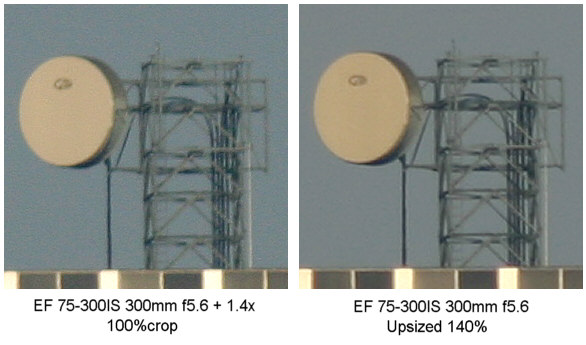 As I think you can see, in this case upsizing the image taken without the TC actually gives slightly better results than using a TC! Contrast is higher and resolution is better. So in this case it seems pretty clear that the conventional wisdom that TCs don't work well with consumer grade telephoto zooms seems to be right. The EF28-135/3.5-5.6ISIn this second test a 10D was used with a Canon EF28-135/3.5-5.6IS lens set to 135mm and f5.6 with an without the Tamron 1.4xTC. A full frame shot is shown below. 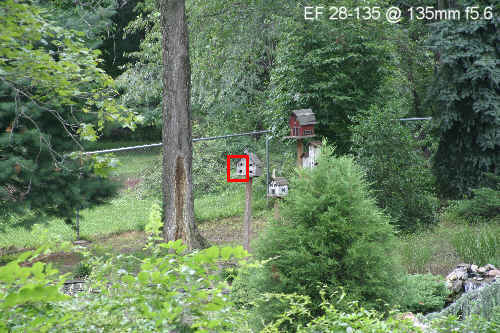 The area in red is enlarged below. On the left is the image upsized by 280% using bicubic interpolation from the lens without the TC, and on the right the image is upsized by 200% using bicubic interpolation. 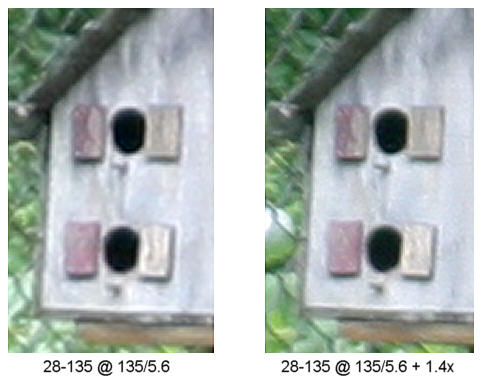 This time I think the results with the TC are slightly better. There's less pixillation and slightly more detail in the image. Not a huge difference, but unlike the case of the 300mm zoom, in which the TC gave worse results, with the shorter range zoom the TC didn't hurt and in fact helped slightly.
The EF 300/4LThe third test was conducted with a Canon EF 300/4L, with and without the Tamron 1.4xTC. Below is the full size image (without TC). 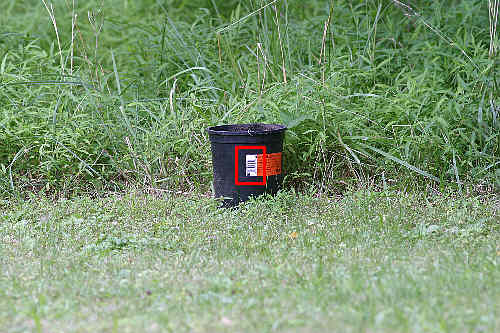 The area outlined in red is shown below. On the left is the image taken without the TC. It has been upsized by 280% so that it matches the image on the right, taken using the 1.4x TC, which has been upsized by 200%.  I think it's pretty clear here that the image shot with the TC shows significantly higher resolution. Look, for example at the 3 closely spaced lines at the top of the UPC pattern. On the right (with TC) they are clearly resolved, while on the left (no TC) they are not. Again this shows that conventional wisdom is, in fact, wise. High quality telephoto prime lenses work well with TCs and produce significantly better results with a TC than can be obtained by upsizing the image shot without the TC. The EF 50/1.8The final test was done using the Canon EF 50/1.8 with and without the Tamron 1.4xTC. Below is the full size image (without TC). 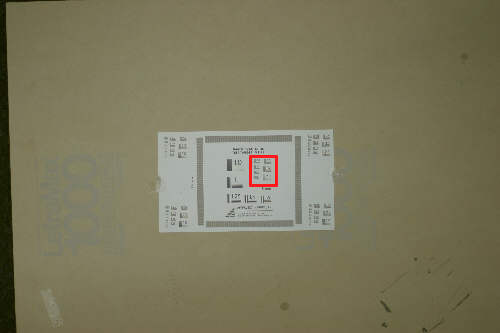 The area in red is shown enlarged below when the lens was used wide open (f1.8) 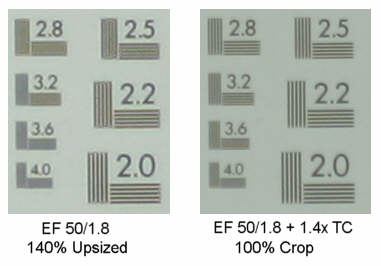 Not much doubt here that the TC gives better results! Below is the test repeated, but this time set to f4.  As expected, the TC is still working very well and overall image contrast is higher. It's actually a little surprising that without the TC the resolution hasn't gone up significantly going from f1.8 to f4, though contrast has gone up and that means a higher MTF and a sharper looking image. It's likely that resolution here is being limited by the resolution of the digital sensor, rather than by the lens. With the TC it appears that resolution and contrast both go up as the lens is stopped down. This TC does very well indeed with this lens and turns the 50/1.8 into a very useful 70/2.5. What about 2x TCs?Since I didn't have a 2x TC which fits on the zooms or 50mm prime I couldn't include 2x results. My guess is that we'd see much the same trend. Useful on the primes, not so useful on the zooms. In general results with a 2x will always be worse then with a 1.4x. A quality 2x on a quality lens can be useful and give excellent results, but a mediocre 2x on a consumer zoom is a recipe for disaster. The shot below was taken with a Canon EF 300/4L lens + Canon 2x TC with the lens set to f5.6 (effective aperture with the TC added was f11). The original full size image is sharp.  Choice of TCWhich TC to buy is always a tricky question. If you have a Canon EOS series EF "L" telephoto, the answer is clear. Get the Canon TC. It will give you better compatibility, better autofocus and better image quality than a 3rd party TC. However, if you want to use the TC on a lens the Canon TC doesn't fit, you have to go 3rd party which means Sigma, Tokina, Tamron or Kenko. They all make a variety of 1.4x and 2x TC (some do a 1.5x, though it's probably the same as the other 1.4x models!). Some have "premium" or "pro" and "regular" versions. You pay your money and you take your chance. Maybe the more expensive models will give slightly better results, maybe not. It's very unlikely that anyone is going to test 8 different TCs with 30 different lenses (240 tests) to see which TC matches best with which lens. While it would be an interesting project, I'd image the tester would start to go crazy after the first 100 or so!

ConclusionsAre TCs "worth it". The answer is yes, as long as you use them with a good lens, preferably a prime lens. The tests here show that this TC is very effective with both the EF 50/1.8 and the EF 300/4L, somewhat effective with the EF 28-135IS, but not really useful with the EF 75-300IS. These results back up the "conventional wisdom" that TCs work best with prime lenses. If you have a Canon "L" telephoto prime or zoom that accepts Canon TCs, the one to get first is the Canon 1.4x TC. It will give higher image quality and better AF (when supported by the EOS body) than 3rd party optionsIf you need a TC to fit Canon non-L series primes or shorter focal length lenses that won't accept the Canon TC, then there are a number of 3rd party options. Generally the 1.4x TCs will give more acceptable results than the 2x versions.
© Copyright Bob Atkins All Rights Reserved |
|||



